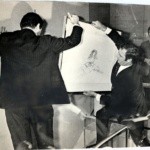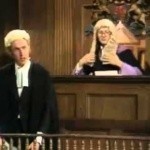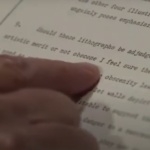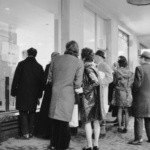In the Lennon Lithograph case, I have now had the time fortunately to look up the case law and although there is no direct decision as to what is a “public place”, I take the view that Section 54 of the 1839 Act is concerned primarily with what one would commonly term nuisances, and I think if this view be correct there are a number of cases where the words “public place had been defined and commented upon judicially.
Without going into details which can be supplied if necessary, I am now firmly of the view that “public place can be said to include the London Arts Gallery, 22, New Bond Street, London, W.1, and I am relying on a number of cases which do not include the case of Howard v. Daniels which frankly, I do not think is of any assistance whatsoever.
I will be grateful for your advise upon one point. The witnesses in the case so far are either Police Officers who executed the Search Warrant or two or three private individuals who had made statements complaining to the Police.
If this were a case under the obscenity laws then I take the view that private individuals are necessary witnesses as they would now have to be asked the question what effect did the articles have on you and their answers would
or would not show that the articles had “a tendency to deprave and corrupt”.
With the present charge however which is simply exhibiting to public view eight indecent prints, I think all that the prosecution have to do is to prove that the eight prints were exhibited to public view and the Police officers in charge of the case can say that members of the public were present, and indeed for this purpose he is a member of the public himself.
I therefore intend only to call one Police officer who can be corroborated by other Police officers if necessary, and leave the matter there.
I take the view I hope correctly that the question as to whether the articles are indecent or not is the question clearly for the Magistrate to decide, and that the views of private individuals whether called for the prosecution or for the defence are irrelevant.
The views of private individuals may be relevant upon the point of mitigation but not relevant upon any other point.
Am I correct in this view as to the calling of witnesses?
K. Horn 11th March, 1970
———————————-
A/De Met,
The offences of this case are summarised briefly in the Police Report. In essence, the facts are that eight lithographs were seized by officers of the Obscene Publications Department at New Scotland Yard from the London Arts Gallery at 22 New Bond Street, W.1, on the 16th of January 1970. The exhibition was organised by Eugene Schuster, and there is documentary evidence to show Mr Schuster’s connection on page 15 of the documents. The search warrant was granted on the 15th of January 1970 by Mr Christopher Leach, the Stipendiary Magistrate at Marlborough Street Magistrates Court, and when this warrant was executed the following day, eight lithographs were seized. These lithographs are shown in the photographic 23 bum. The lithographs are basically those of John Lennon and his wife Yoko and were drawn by John Lennon himself. Lennon and his wife are at the moment in Denmark and so have not yet been interviewed by the police, and to that extent, this report is only an interim report. I will now enumerate the offences which I think have been committed together with my comments.
The Obscene Publication Acts 1959 and 1964.
Under Section 1 of the 1959 Act, the test of obscenity is whether “the article tends to deprave and corrupt persons who are likely, having regard to the relevant circumstances to read, see or hear the matter contained or embodied in it.” Under Sub-Section 2 of Section 1, an article would include matter which is to be looked at, and therefore a lithograph would come within this sub-section. Under Sub-Section 3 of Section 1, a person publishes an article who… Here there may be a defence of artistic merit, but I would have thought myself that this would be difficult to prove, although I may be prejudiced in this matter. I myself see not the slightest artistic merit in any of these lithographs whatsoever.
PROSECUTING UNDER COMMON LAW FOR AN INDECENT EXHIBITION
Sub-Section 4 of Section 2 of the Obscene Publication Act, 1959 states: “A person publishing an article shall not be proceeded against for an offence at Common Law consisting of the publication contained in the article, if it is of the essence of the offence that the matter is obscene.” This sub-section of course begs the question, which is whether the matter is obscene, but as I have always understood the Obscene Publications Acts, they were intended to cover obscene material and to make sure that any question involving obscene material was prosecuted under the Obscene Publication Act, where the question of public good could be raised by the defendant. If the matter was not obscene, then it could fall under other acts such as the Post Office Act or the Indecent Advertisements Act 1889, etc., and if it was not possible to prosecute under the Obscene Publications Act, then one could quite justifiably and properly proceed at Common Law. For some time during the 1960s, in fact, this office did proceed at Common Law for the conspiracy to corrupt public morals on the basis that it was not possible to proceed under the Obscene Publications Act because of the proviso which prevented prosecutions for persons publishing blue films. However, with regard to the facts of this case, in my opinion, these lithographs are obscene and if that is so, then I think a prosecution at Common Law is specifically provided for under Sub-section 4 of Section 2 of the 1959 Act.
METROPOLITAN POLICE ACT, 1839.
Section 54 of this Act states: “If a person who within the Metropolitan Police District in
and corrupted persons likely to see or hear it in the circumstances.” In this case, the lithographs were on display in a public gallery, and it is likely that people who may be affected by the content would have seen them.
Under Section 2 of the Indecent Displays (Control) Act, 1981, it is an offence to display an indecent image in a public place, where the display is likely to cause harassment, alarm, or distress to a viewer. It could be argued that the display of the lithographs in a public gallery meets the criteria for this offence.
Additionally, Section 1 of the Protection of Children Act, 1978, makes it an offence to take, distribute, or possess indecent images of children under the age of 18. While the lithographs in question did not feature children, it is worth noting that this act could come into play in cases involving obscene images of minors.
Overall, it seems that the police report outlines several possible offences related to the display and distribution of the lithographs in question. However, it is ultimately up to the courts to determine whether these offences have been committed and to what extent those responsible should be held accountable.
K.H.



